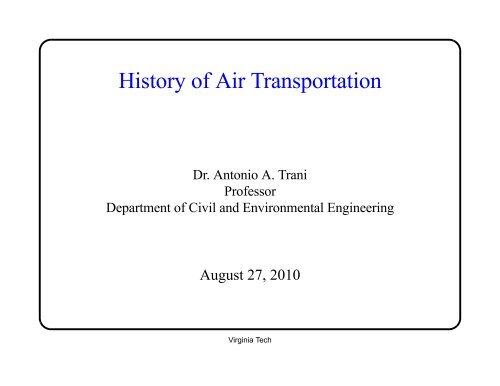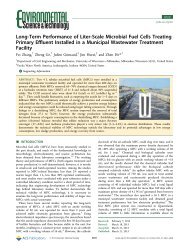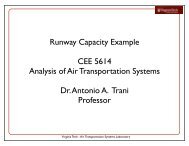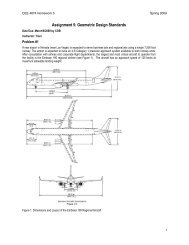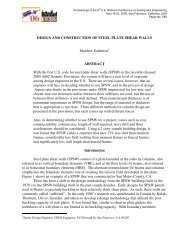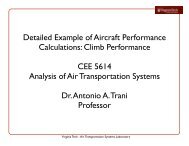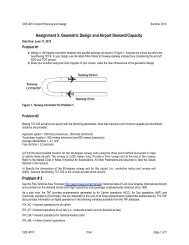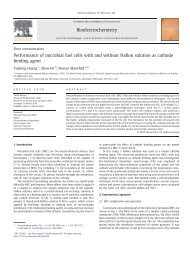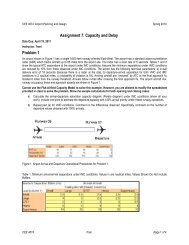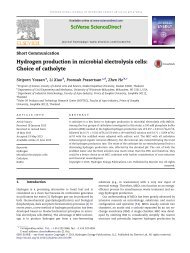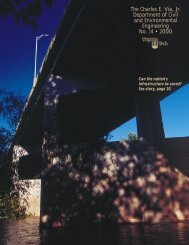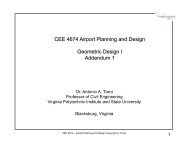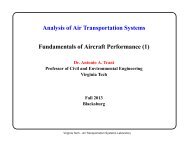Notes 1 - Air Transportation Systems Laboratory - Virginia Tech
Notes 1 - Air Transportation Systems Laboratory - Virginia Tech
Notes 1 - Air Transportation Systems Laboratory - Virginia Tech
You also want an ePaper? Increase the reach of your titles
YUMPU automatically turns print PDFs into web optimized ePapers that Google loves.
Early Developments (II)• 1930s - U.S., Latin America and Europe airlines flourish• 1935 - First air traffic control facility (Newark)• 1936 - The Douglas DC-3 goes into serviceCruise speed = 300 kph21-32 passengersRunway length = 800 m11,000 builtSome still fly todayDouglas DC-3<strong>Virginia</strong> <strong>Tech</strong> 4
Early <strong>Air</strong>lines• The first airlines appear in Europe and the U.S.• Several Latin American carriers also start service in the late 20’sand early 30’s<strong>Virginia</strong> <strong>Tech</strong> 5
Early <strong>Air</strong>ports• In the 30’s airports start adding concrete runways (400-900 m.)• Large flying boats required well prepared facilitiesTampa Bay Seaport (circa 1930) (Blankenship, 1967)<strong>Virginia</strong> <strong>Tech</strong> 6
WWII Period• 1938 - President Roosevelt creates the CAA (Civil AeronauticsAuthority) through the Civil Aeronautics Act of 1938• 1939 - CAA splits into CAA and CAB (Civil Aeronautics Board)• 1939-1945 <strong>Air</strong>craft development during WWII• 1939-1945 Hundreds of low cost airports are created around thecountry to train pilots• 1945-1947 Availability of surplus aircraft (specially many C-47or DC-3)• 500 airports are turned to local and state authorities<strong>Virginia</strong> <strong>Tech</strong> 7
End of WWII Circa <strong>Air</strong>craft• 1946 - The Douglas DC-6 is introduced• Several four engine, (piston) powered aircraft become themainstay of the commercial aircraft fleetCruise speed = 550 kph45-65 passengers300 builtSome still fly today<strong>Virginia</strong> <strong>Tech</strong> 8
Development of the RADAR• Allows the surveillance of aircraft allowing efficient and safeaircraft operations• Primary RADAR is used after WWIISecondary RADAR(transponder)Primary RADAR<strong>Virginia</strong> <strong>Tech</strong> 9
Post War Period• 1945 - First radar equipped control tower (Indianapolis)• 1946 - Federal <strong>Air</strong>port Act of 1946• 1951 - British launch the first commercial jet (Comet I)- <strong>Air</strong>port runway lengths grow substantially- More support equipment is needed• 1958 - Federal Aviation Act of 1958- Creates the Federal Aviation Agency (today’s FAA)- Retains CAB for regulatory control• 1967 - Department of <strong>Transportation</strong> emerges- FAA becomes the Federal Aviation Administration- NTSB is created (National <strong>Transportation</strong> Safety Board)<strong>Virginia</strong> <strong>Tech</strong> 10
<strong>Air</strong>port and <strong>Air</strong>way <strong>Tech</strong>nologies (50’s)Relevant airport/aviation technologies:• Very High Frequency Omni-directional Range and Finding(VOR’s and later VORTAC’s)• Instrument Landing System (ILS)• Approach lighting systemsVORTACILS Antenna<strong>Virginia</strong> <strong>Tech</strong> 11
Representative <strong>Air</strong>craft of the Post War PeriodSeveral successful four-engine, piston and turbo-propeller aircraftare developed in this periodVickers Viscount (Turboprop)Cruise speed = 600 kph90-110 passengersRunway length = 2,000 mLockheed Constellation (Piston)<strong>Virginia</strong> <strong>Tech</strong> 12
Long-Range <strong>Air</strong>craft Development (50-60’s)• The British Comet I is followed by very successful Americanfour-engine turbojet designs from Boeing and DouglasCruise speed = 950 kph140-165 passengersRunway length = 3,000 mDouglas DC-8-50Boeing 707-320<strong>Virginia</strong> <strong>Tech</strong> 13
Short-Range <strong>Air</strong>craft Development (60’s)• Several short and medium-range aircraft are introduced in the60’sBoeing 727-200Cruise speed = 950 kph140-165 passengersRunway length = 2,200 mBoeing 737-100<strong>Virginia</strong> <strong>Tech</strong> 14
<strong>Air</strong>port Development in the 60’sMany of the most famous airports that we know today wereconceived in the late 50’s and early 60’s• Washington Dulles International (1958-1962)• Newark International (1967-1973)• San Francisco International (1967)• Chicago Ohare International (1959-1963)• Los Angeles International (1957-1961)• Paris Orly-Ouest (1966-1971)• Houston Intercontinental (1964-1967)• Kansas City (1965-1972)• Dallas/Fort-Worth Regional (1965-1973)<strong>Virginia</strong> <strong>Tech</strong> 15
Supersonic <strong>Air</strong>craft (Late 60’s)• 1968 - BAC/Aerospatiale introduce Concorde to the world• Only 14 aircraft are ever builtCruise speed = 2400 kph90-110 passengers7,000 km range150,000 kgRunway length = 3,200 m<strong>Virginia</strong> <strong>Tech</strong> 16
Large Capacity <strong>Air</strong>craft (60-70’s)• 1969 - Boeing introduces the Boeing 747-100• PanAm is the first airline to place it into service• <strong>Air</strong>ports have to adjust to this aircraftCruise speed = 985 kph400 passengers7,000 km range320,000 kgRunway length = 3,100 m<strong>Virginia</strong> <strong>Tech</strong> 17
<strong>Air</strong>port Innovations (70’s)In the early seventies new innovations appear at many airports inthe U.S. (Automated People Movers -APM, centralized deicing,mobile lounges, moving sidewalks, etc.)<strong>Virginia</strong> <strong>Tech</strong> 18
Important <strong>Air</strong>port <strong>Air</strong>way Development• <strong>Air</strong>port and <strong>Air</strong>way development Act of 1970- Creates the Aviation Trust Fund- Provided assistance to airports for development• <strong>Air</strong>line Deregulation Act of 1978- Eliminates the regulation activities- Phases out CAB in 1985- Rise and decay of low fare airlines- Consolidation of markets- Growth in commuter markets• 1981 - PATCO strike (11,000 ATC controllers fired by PresidentReagan)<strong>Virginia</strong> <strong>Tech</strong> 19
More Recent Issues• <strong>Air</strong>port and <strong>Air</strong>way Improvement Act of 1982- FAA’s Brown Book (National <strong>Air</strong>space <strong>Systems</strong> Plan - NASP)- Authorizes 11.1 billion dollars for improvements• 1980s - Few megacarriers dominate the domestic market• 1980-1990s More consolidations take place• 1990s - International megacarrier arrangements• 1993 - European liberalization starts• 1990s - Commuter airlines seek alliances with majors<strong>Virginia</strong> <strong>Tech</strong> 20
Development of Twin Engine <strong>Air</strong>craft (70-80-90’s)• Development of large turbofan (fuel efficient) engines• Boeing and <strong>Air</strong>bus introduce successful long-range, twin-engineaircraftCruise speed = 985 kph270 passengersRunway length = 2,700 mBoeing 767-200 7,000 km range200,000 kg<strong>Virginia</strong> <strong>Tech</strong> 21
Satellite Revolution• 1993 - GPS (Global Positioning System) touted as the next ATCrevolution- SATNAV trails over the Pacific Ocean- United predicts 40 million dollars in savings in the Pacific usingGPS• 1994 - Satellite navigation trials start on Trans-Pacific routes• 1996 - Trails to test DGPS for low visibility landings at airports• 1998 - ADS-B Automated Dependance Surveillance mode B• 1999 - DGPS offers near precision approaches (demonstrationsin the Ohio Valley)• 2000 - Alaska trials of ADS-B (250 aircraft participating)<strong>Virginia</strong> <strong>Tech</strong> 22
Development of Regional <strong>Air</strong>craft (80-90’s)• Today turbofan-powered regional aircraft are very successful atreplacing older turboprop technology• Public’s perception of the turboprop as noisy and unsafeBombardier RJ 100Cruise speed = 850 kph50 passengersRunway length = 1,400 m2,000 km range32,000 kg<strong>Virginia</strong> <strong>Tech</strong> 23
<strong>Air</strong>ports for General Aviation UseThe Small (or Smart) <strong>Air</strong> <strong>Transportation</strong> System (SATS) proposedby NASA Langley could bring a new meaning to personal airtransportation<strong>Virginia</strong> <strong>Tech</strong> 24
Very Long Range <strong>Air</strong>craft• In the early 2003 the introduction of <strong>Air</strong>bus A340-500 andBoeing 777-200 ER aircraft allows airlines to fly routes of morethan 7,000 nm (New York-Delhi, New York-Singapore)• New issues with human factors of long flight duration are beingaddressedBoeing 777-200ERCruise speed = 910 kph300 passengersRunway length = 3,000 m13,000 km range325,000 kg<strong>Air</strong>bus A340-500<strong>Virginia</strong> <strong>Tech</strong> 25
<strong>Virginia</strong> <strong>Tech</strong> (A.A. Trani)26
• <strong>Air</strong>bus A380-800Very Large Capacity <strong>Air</strong>craft• 8000 nautical mile range• 500-850 passengers•cruise speed is 85% of speed of sound (Mach 0.85)• http://www.airbus.com/en/aircraftfamilies/a380/home/• Boeing 747-8• Cargo and passenger versions• 8000 nautical mile range• 420-550 passengers•cruise speed is 85% of speed of sound (Mach 0.85)• http://www.boeing.com/commercial/747family/specs.htmlsource: Boeing<strong>Air</strong> <strong>Transportation</strong> <strong>Systems</strong> (A.A. Trani)28
New Generation Twin Engine <strong>Air</strong>craft(Heavy Use of Composite Materials)• Boeing 787 Dreamliner• Two versions(787-8and 787-9)• 8000 nautical mile range• 210-290 passengers•cruise speed is 85% of speed of sound (Mach 0.85)• http://www.boeing.com/commercial/787family/programfacts.htmlsource: Boeing• <strong>Air</strong>bus A350 XWB• Three versions(A350-800,-900 and -1000)• 8000 nautical mile range• 270-350 passengers•cruise speed is 85% of speed of sound (Mach 0.85)• http://www.airbus.com/en/aircraftfamilies/a350<strong>Air</strong> <strong>Transportation</strong> <strong>Systems</strong> (A.A. Trani)source: <strong>Air</strong>bus28
Next Generation <strong>Air</strong> <strong>Transportation</strong>System (NextGen)• FAA Program to modernize the <strong>Air</strong> Traffic Control <strong>Systems</strong>ource:• Several key technical capabilitiesFAAhttp://www.faa.gov/about/initiatives/nextgen/library/<strong>Air</strong> <strong>Transportation</strong> <strong>Systems</strong> (A.A. Trani)28


